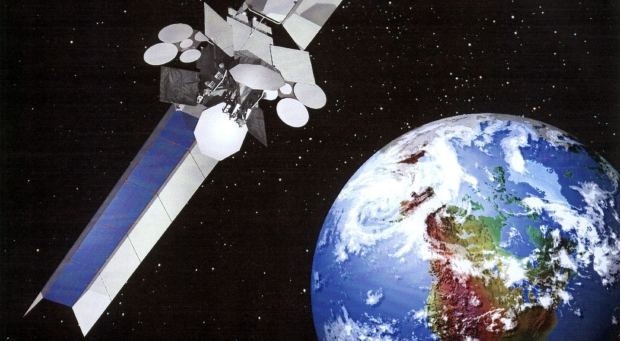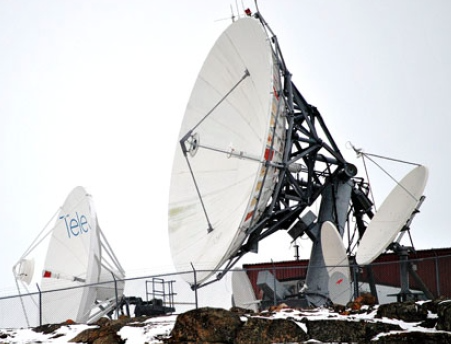
A picture of Telesat's Anik F2 satellite, which is currently malfunctioning and causing major communications outages in the North. (Telesat)
Good news when a satellite that has been off line creating lost services is corrected and back online. The positive information today is as follows:
OTTAWA, CANADA, October 3, 2016 – Telesat confirms that, following a technical anomaly that occurred on its Anik F2 satellite yesterday, customer services on Anik F2 were restored early this afternoon. The satellite is performing normally and all of its subsystems appear healthy.
Satellite anomalies like the one that affected Telesat’s Anik F2 yesterday are highly unusual. Telesat is continuing to investigate the root cause of the anomaly and will advise affected customers as more details become known.
Yesterday's News...
Sometimes things happen in space that aren't planned, and so it is with Telesat's Anik F2 satellite. The announcement from Telecast is as follows:
This evening at approximately 17:00 EDT Telesat’s Anik F2 satellite experienced a technical anomaly that resulted in loss of satellite services to its customers. Telesat is now undertaking to return the satellite to normal operations and will work to restore traffic in an orderly manner to minimize the impact to our customer networks. Telesat is in control of the satellite and all indications are that it is healthy. Although there can be no assurance, we expect it will be returned to service by noon EDT tomorrow (i.e., Monday, October 3, 2016).
Further updates will be provided once additional information is available.

The Telesat Anik F2 satellite stopped working around 5 p.m. ET Sunday, resulting in a widespread service outage, but internet and phone services in parts of Northern Canada started returning Monday. (telesat.com)
One of the major services that was interrupted was Northwestel phone and Internet services. The disruption to their services was noted as follows from CBC News
Northwestel phone and Internet services have been restored in all satellite-served northern communities after problems with a Telesat satellite disrupted communications in a wide swath of northern Quebec and Nunavut on Sunday afternoon. After more than 12 hours, debit and credit services in much of Nunavut are finally back online.
"There was a major inconvenience for our customers, but thank God in the last 10 minutes things are up and running and we're ready to go," said Jim Jones, manager of Arctic Ventures Marketplace in Iqaluit.
The Telesat Anik F2 satellite cut out around 5 p.m. ET Sunday.
In a statement, the company said the satellite, which helps provide cellphone and Internet service to communities across the North, experienced a "technical anomaly" that resulted in loss of services.
The outage would also have impacted ATMs and aircraft in some communities, said John Flaherty, vice-president of marketing for Telesat, early Monday morning.
The satellite provides service to providers such as Northwestel, Shaw Direct, Xplornet, Bell Mobility and US satellite Internet provider Wildblue.
Shaw Direct said in a tweet that the outage is creating a signal issue for its French stations and HD channels.
It said "the affected satellite performed emergency movements for reasons that are currently under investigation." Shaw estimates service will be restored at 11:30 a.m. ET.
Not all teleservices were inconvenienced. Nunatsiaq Online reported
The problem affects all services routed through the Anik F2, said John Flaherty, Telesat’s vice president of business development and marketing.
But some services in some communities are continuing to function through the Anik F3 satellite, Flaherty said. That includes Northwestel internet in Iqaluit and SSI Micro’s Qiniq internet service.
That’s because these and some other customers re-organized their systems to include the Anik F3, Flaherty said, which gives them more redundancy.
As for the cause of the problem, Flaherty said the company is working on some “hypotheses” but at this point is working on restoring service.
The glitch appears to have affected all communities served by telecom companies that use Telesat as their backbone provider, including all communities in Nunavut.
In a public service announcement, the Government of Nunavut said officers working at Nunavut health centres, airports and government liaison offices should ensure their satellite phones are fully charged, turned on and working properly.
“Please note that you will get the best results when you are using your satellite phone outside. If there is a need to report an emergency, please contact Nunavut Emergency Management at 1-867-222-0208 or 1-800-693-1666,” the PSA said.
The GN also said they expect most services to be restored between 12 noon and 3 p.m. eastern time.
The Anik F2 satellite was at the center of a major incident on October 6, 2011, when Telesat ground crews lost control of the space craft when they were attempting to upload new software.
The satellite ended up pointing in the wrong direction, knocking out long distance voice phone, Internet, television ATM banking and other services for about 16 hours.
This most recent problem appears to be less serious and Internet service appeared to be restored in Iqaluit as of the morning of October 3, although long distance phone was not working. Local land line service was not affected.
Also, the Ice Wireless cellular service, which uses a different satellite company, was also working in Iqaluit.
However, Northwestel, a Telesat customer that serves many satellite-based communities, reported a disruption to all services in “satellite served communities in the NWT, Nunavut, B.C. and Yukon.”
“Technicians are currently working to restore this service,” Northwestel said.
The Anik F2 was launched in 2004 with a expected life of about 15 years. But it likely carries enough fuel to continued functioning well beyond 2019, Flaherty said.
A new generation of Telesat satellites will likely be launched in the 2020s, he said.

